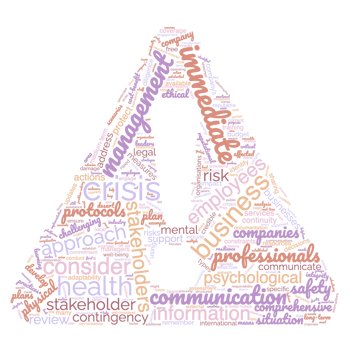Várri Consultancy Named Clutch Global Leader and Clutch Champion for 2023
Várri Consultancy attributes its success to personalised senior-level client engagement and consistently delivering outstanding quality.
7 min read
Johnny Kollin
:
21 October 2023 19:59:56 GST

In the business landscape, crises are as inevitable as the precarious terrains of an arctic mountain or the shifting sands of a desert. Effective leadership in such scenarios is not merely about damage control—it is akin to navigating these complex terrains with a seasoned climber’s sure-footedness and a desert survivor’s adaptability.
While the talk in many boardrooms tends to hover around established management frameworks and preordained contingency plans, the stark reality is that many enterprises, particularly smaller ones, find themselves as unprepared as a mountaineer facing an unexpected storm or a wanderer caught in a desert storm. If your organisation lacks a comprehensive crisis management strategy, the task ahead might seem as challenging as scaling a peak or crossing a desert. Still, it is a journey that is both a responsibility and an opportunity for transformative leadership.
This article provides a simplified guide for leaders operating without an existing crisis management framework. It focuses on actionable steps to contain damage, preserve integrity, and meet your responsibilities. While the tactical measures are at the forefront, it is imperative to remember that an effective approach to crisis management is incomplete without compassion, ethical integrity, and a deep sense of social responsibility.
The saying "Time is of the essence" takes on vital importance when an organisation is thrust into the chaos that a crisis inherently brings. This section delves into some immediate actions that may be taken to ensure physical safety and safeguard mental well-being. From establishing robust protocols for employee safety to identifying the means for psychological support, our focus is on actions that are not just timely but also meticulously planned and effectively executed.
Immediate actions geared towards ensuring physical safety can make the difference between containment and catastrophe. The management of occupational safety and health should be an integral part of an organisation's overall operations, as confirmed in the UAE Occupational Health and Safety Management System (OHSMS) National Standard. The standard can serve as an informatory guide for UAE-based businesses in creating safety and health protocols tailored to their specific operational scope and context.
Identify the types of risks employees might face in a specific crisis scenario and design robust yet flexible protocols to address the identified risks. These protocols may include evacuation plans, shelter-in-place instructions, and multiple means of communicating urgent information, such as redundancy in communication channels (e.g., automated SMS alerts, emails, and company intranet).
Companies lacking established protocols should convene a cross-functional team to swiftly conduct a risk assessment. The review will allow them to develop interim measures to implement immediately while formulating a more comprehensive plan for the medium term. Small businesses with budget constraints may consider using templates and best practices in the public domain as a starting point while consulting with external risk advisers for a more tailored approach as resources allow.
Identify local organisations that can offer immediate help and, if available, evacuation services to employees in the affected area. Verify and relay the information to affected employees. Companies should conduct due diligence, taking a risk-based approach, before engaging with local organisations, especially in conflict zones and high-risk countries, to ensure they are credible and have a track record of effective intervention in crisis scenarios. Such due diligence may include cross-referencing with international bodies, checking published reports, or seeking feedback from other reputable businesses operating in the region. Establishing partnerships or lines of communication with such organisations in advance can speed up the provision of emergency assistance when needed.
As vital as physical safety is in a crisis, the mental well-being of employees is an equally critical component that should not be overlooked. By taking a structured approach to safeguarding psychological health during challenging times, leaders and managers can ensure a holistic approach to employee well-being, even amid the unpredictability of crisis situations.
The emotional toll on employees can be substantial in the wake of a crisis. While the instinct to provide immediate psychological support is understandable, it is essential to exercise caution. Line managers and other supervisory personnel are not qualified to provide professional mental health support unless they have received specific training in psychology or counselling. The risk of well-intentioned but ultimately harmful advice can have legal and ethical implications for the organisation.
Therefore, the first step in offering psychological support is to review your company's insurance policies to ascertain the extent of mental health coverage available. This should be an integral part of your crisis management plan. As soon as you understand the available resources, you should clearly communicate this information to all employees. This ensures that they are aware of their options for professional psychological support, whether through insurance-covered psychologists and therapists, telemental health services, or other approved mental health resources.
Crises can take a toll on the mental well-being of not only those directly affected but also those engaged in crisis management, as pointed out in the international standard ISO22361:2022 (Security and resilience – Crisis management – Guidelines). It is, therefore, prudent to extend mental health support resources to employees who may not be directly impacted by the crisis but could benefit from it and their families.
If your current employee healthcare insurance policy does not provide telemental health service coverage, you may curate a list of reputable online telemental health platforms and crisis helplines. The list can be used as an interim reference point for employees in need of immediate assistance. As a temporary measure, consider subsidising the cost of these services for your staff or opt for reputable, free alternatives if budget constraints are an issue. There are numerous free support groups and helplines operated by clinics in the UAE.
Consider completing a brief training session for all line managers on recognising signs of stress or trauma to empower them to refer any employee at risk to health professionals. If budget constraints prevent formal training sessions, look for credible, free online resources or webinars that provide similar guidance to managers.
Real-Time Recording: You can begin ongoing real-time documentation as soon as the actions are completed. Too often, companies leave this until after a crisis, when they may have lost the nuances of decisions made. Keep a detailed log of critical decisions, including the reasoning and circumstances under which management took them. This practice is crucial not only for post-crisis evaluations but also for any legal scrutiny or regulatory compliance that may arise later. Annotations should include dissenting opinions, if any, as they can provide valuable insights during a retrospective analysis.
Identifying Stakeholders: A common mistake in crisis management is having a narrow view of affected parties. Companies should ensure they identify all stakeholders and how the current situation may impact them. View any proposed action through the lens of each stakeholder group. To do this effectively, list all potential stakeholders and categorise them in a stakeholder matrix using one of the available techniques. For example, the Stakeholder Salience Model may be used for categorising stakeholders based on their power, legitimacy and urgency.
Impact Reassessment: Periodically reassess the impact on stakeholders as it may evolve. Do this by regularly updating the stakeholder matrix as the crisis develops, re-evaluating your strategies accordingly, and considering how different courses of action may impact diverse stakeholders differently.
Commitment to Updates: Establish a protocol for internal and external crisis communication. Let your stakeholders know how often, when, and how you will communicate, and make sure you stick to that commitment.
Transparency: Communicate your efforts to stakeholders in a transparent but non-exploitative manner. This means being able to be forthright about your actions and challenges without leveraging the crisis for marketing or promotional purposes. An open line of communication maintains trust and credibility, forming the foundation for more resilient stakeholder relationships in the long term.
Contingency Plans: Develop a contingency plan for the current crisis that considers any business interruptions to protect the company and its employees. Make sure the contingency plan is communicated clearly to all relevant parties, from the board of directors, through management to front-line staff, to facilitate smooth implementation.
Build a Resilient Team: Offer your staff training on building personal resilience. Plenty of online training programs are available, including a free online course by Harvard University on building personal resilience by managing anxiety and mental health.
Updates and Reassessments: Regularly update the business continuity plan based on new information as the situation evolves.
Review and Measures: Review what company risks may have changed due to the crisis and take measures to treat those risks. One concrete example is charitable donations - a highly regulated area in the UAE. Protect your employees who are not directly affected by informing them of these aspects.
Ethical and Legal Obligations: Consider your company’s ethical and legal obligations. Keep it dynamic as the situation evolves. This will help protect your business and your employees.
Cost-Benefit Analysis: Careful resource allocation is paramount in crises for small businesses. After you have set the immediate and medium-term actions in motion, conduct a cost-benefit analysis to evaluate the necessity and timing for bringing in external professionals.
Types of Professionals: Engage risk professionals for a comprehensive risk assessment if the situation involves substantial financial, legal, or reputational risk or if the crisis has multiple complexities that your internal team is not trained to handle. Depending on the scale and complexity of the crisis, risk professionals or security consultants specialised in crisis management may be required. You may also need to engage a public relations firm specialising in crisis management communications if there is a risk of significant reputational damage. Given budget constraints, consider initially opting for consultancy-based services rather than a full-scale engagement to address the most critical aspects of the crisis.
Continuous Improvement: Consider how you can improve your company’s business continuity and crisis management activities based on the ongoing documentation and lessons from this experience.
Holistic Planning: Develop a comprehensive business continuity and crisis management plan. Initial guidance can be drawn from business continuity frameworks like ISO 22301:2009 (Business Continuity Management Systems) and ISO 22361:2022 (Crisis Management). The immediate (interim) plan should encompass immediate reactive steps, while the longer-term plans should also include proactive strategies to build resilience and adaptability. Make sure the plans are scalable and versatile to address a variety of potential crises.
Industry Collaboration: Consider sharing non-confidential learnings with industry peers, for example, through official industry groups. Sharing best practices can elevate the industry’s preparedness and foster a collaborative environment for mutual growth and problem-solving.
 In a world full of uncertainty and where unexpected events have become the norm, failing to prepare for crises is not just an oversight—it is a significant operational, ethical, and reputational risk. As we have explored, managing a crisis is not merely a reactive process but a multi-faceted strategy that spans from immediate action to long-term planning.
In a world full of uncertainty and where unexpected events have become the norm, failing to prepare for crises is not just an oversight—it is a significant operational, ethical, and reputational risk. As we have explored, managing a crisis is not merely a reactive process but a multi-faceted strategy that spans from immediate action to long-term planning.
For leaders, especially in organisations that lack pre-existing business continuity and crisis management plans, embracing a comprehensive crisis management strategy is both an obligation and an opportunity. It is an obligation to protect the well-being of employees, uphold social responsibilities, and safeguard organisational assets. Simultaneously, it presents an opportunity to display transformative leadership, build a resilient corporate culture, and ultimately mitigate future crises more efficiently.
Staying vigilant and continuously adapting your crisis management strategies is imperative in this dynamic landscape. While protocols, training, and risk assessments are essential, never underestimate the power of ethical integrity, compassion, and social responsibility. Consider this not as an end but as a starting point. As you navigate your organisation through known and unforeseen crises, let your actions speak louder than any manual or guidebook ever could. After all, in times of crisis, actions will always resonate more profoundly than any manual or guidebook.

Várri Consultancy attributes its success to personalised senior-level client engagement and consistently delivering outstanding quality.

Saturday, March 1, marks the beginning of Ramadan 2025, following the sighting of the crescent moon in the UAE. As Ramadan begins, individuals and...

Várri Consultancy was awarded a Clutch Leader in a data-driven ranking of the leading B2B service providers in the United Arab Emirates (UAE) 2022.